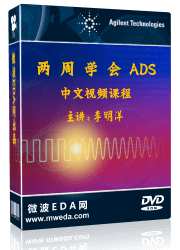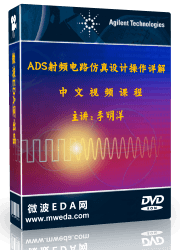- 易迪拓培训,专注于微波、射频、天线设计工程师的培养
How to set the conductor layer of the substrate??
Hi, I am doing a CPWG momentum simulation.
(layout.png)
Here is my substrate setting.
(substrate.png)
For the conductor layer, I choose the "Intrude into substrate" because I think the thickness of the conductor is important for my design.
https://community.keysight.com/message/71766#comment-71766
It indicated that "If the physical thickness is relevant, for example with a narrow gap between two thick metals, then use "intrude" so that the microstrip conductor extends into the air above. For most other microstrip where the physical thickness does not change the fields, use "sheet".")
But there are two warnings when I do the simulation:
1. "Layout healing changed the layout. The actual highest aggregate snap distance was 0.04 mm.
Further details have been written to the DRC report."
I don't know if my layout have any problem.But when I turn off the "heal the layout", the warning then disappear.
2."The 2D port solver data is not available for thick conductor feedlines, using default values (50 Ohm)
for the transmission line parameters. "
I think it is because I choose "intrude into substrate" for the conductor layer. This is indeed the case, for when I choose the "sheet" for the conductor layer, the warning then disappears.
But the results are different between these two settings:
I do the em cosimulation, and here is my schematic and result :
(cosimulation.png)
(result.png)
Which result is more similar to the real measurement??
There is a warning when I do the cosimulation:
"Warning detected by hpeesofsim during SP analysis `SP1'.
COMPONENT `I__3.em_data':
Model data retrieved from "
What does the warning mean??
Thanks for all the reply~~
附图/附件

layout.png

substrate.png

heal the layout.png

cosimulation.png

result.png
> For the conductor layer, I choose the "Intrude into substrate" because I think the thickness of the conductor is important for my design.
Correct.
> But there are two warnings when I do the simulation:
> 1. "Layout healing changed the layout. The actual highest aggregate snap distance was 0.04 mm.
> Further details have been written to the DRC report."
> I don't know if my layout have any problem.But when I turn off the "heal the layout", the warning then disappear.
The layout healing made some minor modifications to your layout, to "clean" extra vertices or small gaps. Nothing to worry about this warning!
> 2."The 2D port solver data is not available for thick conductor feedlines, using default values (50 Ohm)
> for the transmission line parameters. "
> I think it is because I choose "intrude into substrate" for the conductor layer. This is indeed the case, for when I choose the "sheet" for the conductor layer, the warning then disappears.
Again, nothing to worry about. The 2D port solver is enabled by default in some older ADS releases and you will see this warning when you use any thick metal model. In the latest release it is switched off by default, so that you no longer see this warning.
> But the results are different between these two settings:
> I do the em cosimulation, and here is my schematic and result :
> (cosimulation.png)
> (result.png)
> Which result is more similar to the real measurement??
As you might expect, thick metal simulation is more accurate, because it is closer to the real world.
> There is a warning when I do the cosimulation:
> "Warning detected by hpeesofsim during SP analysis `SP1'.
> COMPONENT `I__3.em_data':
> Model data retrieved from
"
> What does the warning mean??
[Irony on] It means that ADS programmers didn't expect customers to actually *use* that emModel feature. [Irony off]
Nothing to worry about, again. The message tells you that the emModel has pre-existing data from a previous EM run, and that data from the cache is now used, instead of running the EM simulation again. So it basically tells us that the emModel does what it is designed to do: cache existing results and re-use them when the schematic simulation needs data for the EM block.
Hi volker:
Thanks for your reply.
Can I ask you another question about the em setup?
Again here is my design,which is an input matching of a power amplifier pcb board,
(pic3.png)
,and my em mesh setup.
(pic4.png)
I want to see the input impedance from port 1 at freq=2.14GHz.
The ref impedance of port 1 is 2.981+j*4.752 Ohm, and other ports are 50 Ohm
I don't know how to set up the mesh.
1. edge mesh
I see other online tutorial, and it mentioned that " If it is defined as Sheet then we need to use Edge Mesh as defined in point (5) later. Edge Mesh can be ignored if we are defined conductor as Thick conductor."
For the conductor layer, I choose the "Intrude into substrate", so is it OK if I don't choose the edge mesh??
But I have compared both the results, and there are some difference between them.
(Please see the pic1, where red point is without edge mesh,and blue point is with edge mesh.)
Which one is more similar to the result of measurement??
2. mesh reduction
The tutorial also mentioned that "Mesh reduction is a technology that automatically removes these redundant degrees of freedom, prior to the solution of the problem. Hence, it should have a negligible impact on the accuracy of the results."
I have compared both the results, and there are some difference between them.
(Please see the pic2, where both are with edge mesh, but red point is with mesh reduction,and blue point is without mesh reduction.)
Which one is more similar to the result of measurement??
3.transmission line mesh
I checked the box of transmission line mesh, but the Num of cells in width is 0 as default.
But the result has no difference.
When do we use the transmission line mesh??
Thanks for your reply~~
附图/附件

pic1.png

pic2.png

pic3.png

pic4.png
> (Please see the pic1, where red point is without edge mesh,and blue point is with edge mesh.)
> Which one is more similar to the result of measurement??
The general rule is: fines mesh is more accurate.
So you should have more accurate results with edge mesh.
If mesh reduction changes results, you should switch it off.
Regarding transmission line mesh, I see no need to use that.
Ok, I see.
It is more accurate with edge mesh and without mesh reduction.
Thanks for your reply.
申明:网友回复良莠不齐,仅供参考。如需专业帮助,请学习易迪拓培训专家讲授的ADS视频培训课程。
上一篇:executing file of ADS simulation
下一篇:Ideal Frequency Multipliers in ads
ADS濠电姷鏁搁崑鐐哄垂閸洖绠归柍鍝勬噹閸屻劌霉閻樺樊鍎忛柛鎴犲█閺屾盯骞囬崗鍝ュ嚬闂佸摜濮村Λ婵嬪蓟濞戙垹鐒洪柛鎰屽懐绠掗梻浣告惈濡酣宕曢悽绋胯摕婵炴垯鍨归悡娑㈡煕閹邦喖浜鹃柡渚囧灠椤啴濡堕崱妯煎弳闁诲孩纰嶅姗€顢氶敐澶樻晝闁冲灈鏅滈悗濠氭⒑閻熸壆鎽犳慨濠傜秺閹繝鏁撻敓锟� | More...

ADS闂傚倷娴囧畷鐢稿窗閹扮増鍋¢柕澶堝剻濞戞ǚ鏀介悗锝冨妷閸嬫捇宕掗悙鏌ュ敹闂佸搫娲ㄩ崑鐐烘倵椤掆偓閳规垿鎮欓崣澶樻濠电偛鐡ㄥ畝绋跨暦濠靛宸濋悗娑欋缚閸橀亶姊洪崘鍙夋儓闁哥姵宀稿銊╂偋閸稐绨婚梺鍝勫€搁悘婵嬵敂椤愶附鐓欏瀣閳诲牏鈧娲樼划蹇浰囬鈧弻锛勪沪鐠囨祴鍋撻弴銏犵厴闁硅揪绠戠壕鍏肩箾閹达綁鍝洪柣锝堟椤啴濡堕崘銊ュХ闂佺懓鍤栭幏锟�
濠电姷鏁搁崑鐐哄垂閸洖绠伴柛顐f礀绾惧綊鏌¢崶銉ョ仼缂佺姷濞€閺屾盯鍩勯崘顏呭枦闂佺ǹ顑嗛幐鎼佸煡婢跺﹦鏆﹂柛銉㈡櫇閻涖儳绱撻崒娆愮グ濞存粠鍓欓‖濠囨儌婵夛拷2012,ADS2014
ADS闂傚倷娴囬褏鎹㈤幇顔藉床闁归偊鍠掗崑鎾愁潩椤愩垹绁梺闈涙閸婂骞戦崟顒佸闁哄洨濮撮弸娑㈡煕閳轰礁顏€规洘锕㈡俊姝岊槻閻犱焦鐓″缁樻媴鐟欏嫨浠у┑鐘噰閸嬫挾绱撴担鐟扮祷妞ゎ厾鍏橀獮鍡楃暆閸曨偆顦悷婊冨閸掑﹥绺介崨濠勫幍闁荤喐鐟ョ€氼剚鎱ㄩ敃鍌涚厱婵﹫绲芥禍楣冩⒒娴h棄鍚瑰┑顔芥綑闇夐柛鏇ㄥ幘娑撳秹鏌熼悜妯诲闁哄棴鎷�
ADS闂備浇顕уù鐑藉极婵犳艾纾诲┑鐘叉搐缁愭鏌″搴″箺闁稿鍔嶉妵鍕箛閵婏箑娅氶梺鍓插亽娴滎亪寮婚弴銏犻唶婵犻潧娴傚Λ鐐烘⒑濮瑰洤濮傜紒鐘崇墵瀵鈽夐姀鈩冩珳闂佸憡鍔戦崝宀勶綖閸涱収娓婚柕鍫濇閳锋劖绻涢崣澶岀煉妤犵偛绻掗埀顒婄秵閸犳牠鎮樺畷鍥e亾鐟欏嫭绀€婵炲眰鍊濋獮鍐敂閸喓鍘介梺缁樓规禍顒傜驳韫囨稒鐓欓柛鎴欏€栫€氾拷
 国内最全面、最专业的Agilent ADS培训课程,可以帮助您从零开始,全面系统学习ADS设计应用【More..】
国内最全面、最专业的Agilent ADS培训课程,可以帮助您从零开始,全面系统学习ADS设计应用【More..】
- Agilent ADS教学培训课程套装
- 两周学会ADS2011、ADS2013视频教程
- ADS2012、ADS2013射频电路设计详解
- ADS高低阻抗线微带滤波器设计培训教程
- ADS混频器仿真分析实例视频培训课程
- ADS Momentum电磁仿真设计视频课程
- ADS射频电路与通信系统设计高级培训
- ADS Layout和电磁仿真设计培训视频
- ADS Workspace and Simulators Training Course
- ADS Circuit Simulation Training Course
- ADS Layout and EM Simulation Training Course
- Agilent ADS 内部原版培训教材合集




